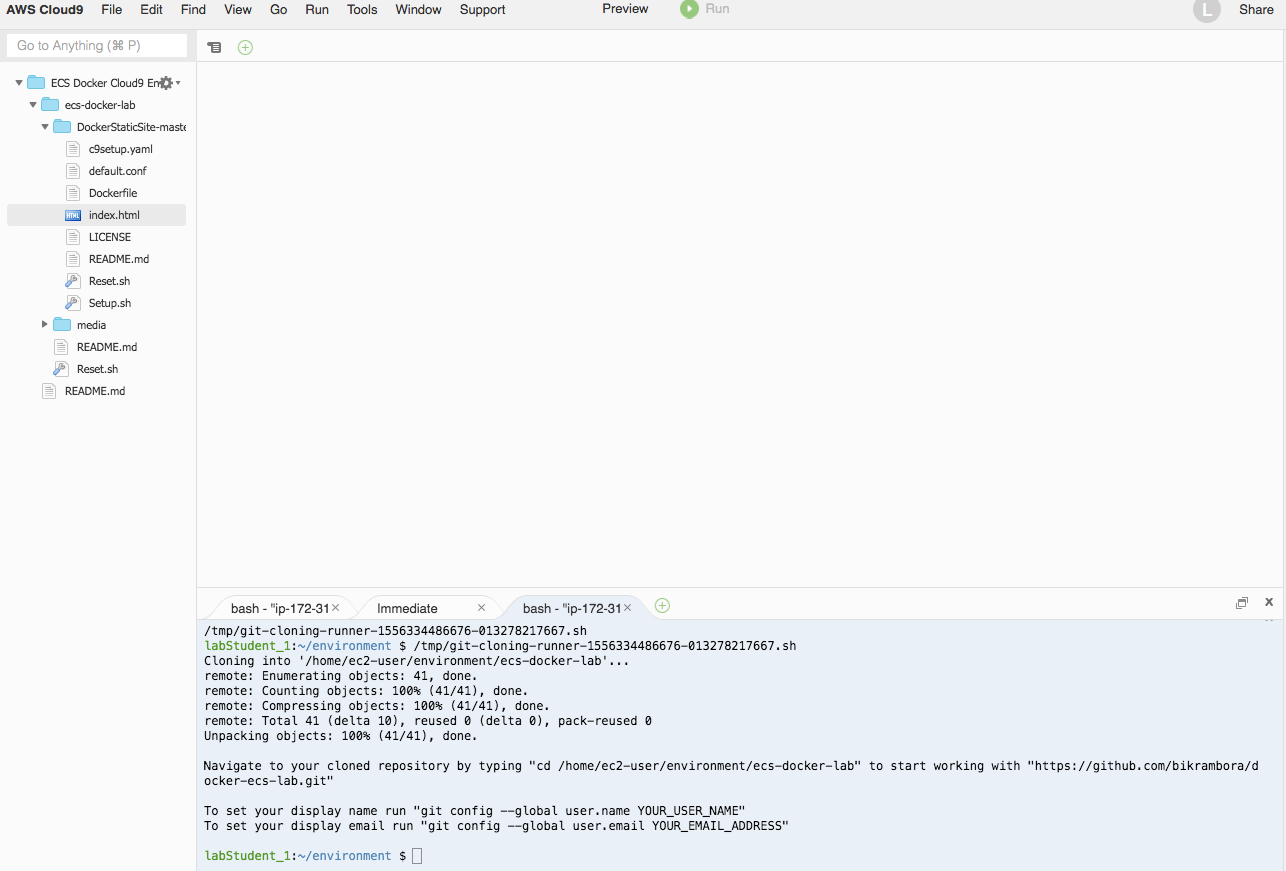Build, Run and Deploy a Containerized Web Application using Docker and Amazon Elastic Container Service (ECS)
In this lab we will learn how to build and run a containerised application. We will then use the Amazon Elastic Container Service to host and run this container in the Cloud.
The diagram below illustrates the architecture the lab will be using. There is currently a version of this architecture deployed for you in the cloud. In this lab we will be deploying a new version of our containerized application onto this cluster.
Go to Cloud9 on the AWS Web console - this is your IDE in the cloud. You can also use your local IDE for all the steps of this lab.
- on top right corner - Switch to N.Virginia (us-east-1)
Open the "ECS Lab Cloud 9 Env" By clicking on Open IDE
Once Inside Cloud9 - Open the Terminal change directory to the correct folder & reset the lab
$ cd ~/environment/ecs-docker-lab/
$ chmod +x Reset.sh
$ ./Reset.sh
$ clear
Install and run docker
$ sudo yum update -y
$ sudo yum install -y docker
$ sudo service docker start
$ sudo usermod -a -G docker ec2-user
Check if docker is installed and running corectly
$ docker info
Open the index.html file inside the Dev Labs folder and edit the Write something here
The next person will read what you put in so please be respectful
- Save your edited HTML File
Build a container Image from the DockerFile
$ docker build -t staticsite:1.0 DockerStaticSite-master/
Run a container from the freshly built image
$ docker run -itd \--name mycontainer \--publish 8080:80 staticsite:1.0
Test if your container is running
$ curl http://localhost:8080
If you get an HTML page as a response, then the container is running successfully - well done!.
Now that your containerized application is running locally, let's push your docker image to a ECR (Elastic Container Repository) repository in the cloud
Navigate to the ECS (Elastic Container Service) console and click on Repositories
Click on "ecs-lab-repo"
Click on "View Push Commands "
You will see a set of commands
Go back to cloud9 cd into the correct folder
$ cd DockerStaticSite-master/
Follow the steps of the push commands to build and push the new modified image to the cloud repo
Once the push is completed your docker image will be pushed to an ECR image repository on AWS
An ECS cluster is already provisioned for you. This cluster is currently running a previous version of the same application. You will now Deploy the your new application Version to the service
Navigate to the Elastic Container Service Dashboard.
In the navigation menu on the left, click Task Definitions.
-
select the simplewebtask
-
checkmark simplewebtask
-
click Create New Revision
-
scroll to the bottom of the page, then click Create
This will create a new version of the Task. Note the Version Number. The new version will use the latest container image. i.e. the image that you just pushed.
-
in the left navigation pane, click Clusters.
-
in the Clusters window, click default >.
This is the cluster that your service resides in.
-
on the Services tab, check webService
-
click Update then click on Revision
-
Revision: select the latest version that you just created
-
Force New Deployment -- check this box & turn it on
-
click Next Step
-
on Step 2, click Next Step
-
on Step 3, click Next Step
-
on Step 4, click Update Service
This will deploy a new version of the application.
-
on the Launch Status page, click View Service
-
on the Service: myService page, click the Events tab.
Wait a few minutes. Monitor the process of draining connections and stopping tasks till the service reaches a steady state.
You may need to click the Refresh button to see the new events.
Once the events says "service webService has reached a steady state."
-
Go to EC2 service page
-
On the left hand pane click on load balancers
-
search and click on myLoadBalancer
- Paste in the Load Balancer's DNS name to see the new version of the app running in the cloud
Congratulations! Your Containerized web application is Now Running in the cloud
$ chmod +x Reset.sh
$ ./Reset.sh
https://docs.aws.amazon.com/AmazonECS/latest/developerguide/docker-basics.html
https://docs.aws.amazon.com/AmazonECS/latest/developerguide/Welcome.html
https://docs.aws.amazon.com/AmazonECS/latest/developerguide/AWS_Fargate.html











